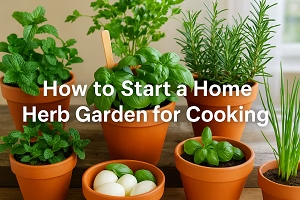Imagine plucking fresh basil or mint right from your window sill while cooking dinner. Sounds dreamy? It’s totally doable! Starting a home herb garden is easier than you think. Whether you live in a house or a tiny apartment, you can grow herbs that elevate your food, save grocery trips, and boost nutrition.
🌱 Why Grow Your Own Herbs?
- Fresh Flavor: Add vibrant taste to dishes instantly
- Budget-Friendly: Herbs can be pricey—growing them is cheaper
- Convenient: No more last-minute store runs
- Healthy: Herbs like parsley, cilantro, and thyme offer antioxidants and vitamins
- Eco-Friendly: Reduces packaging waste and transportation emissions
🪴 Best Herbs to Grow at Home

Start with easy-to-grow, frequently used herbs:
Chives – Mild onion flavor for eggs, salads, and dips
Basil – Great for pasta, salads, and pizzas
Mint – Ideal for tea, chutneys, and desserts
Coriander (Cilantro) – Perfect for Indian, Mexican, and Asian cuisine
Parsley – Adds freshness to almost any dish
Thyme & Rosemary – Aromatic and great for roasting and soups
🏡 Where to Grow Your Herbs
You don’t need a huge garden! Consider:
- Windowsills: South-facing windows are best
- Balconies or terraces
- Kitchen countertops (with sunlight)
- Vertical wall planters or hanging pots
🧤 Step-by-Step: Starting Your Herb Garden
- Choose Your Herbs: Start small—pick 3–5 you’ll actually use.
- Pick the Right Containers: Ensure they have drainage holes.
- Use Quality Soil: Go for well-draining potting mix.
- Water Carefully: Herbs don’t like soggy roots—keep soil moist, not soaked.
- Provide Sunlight: Most herbs need 4–6 hours of direct sunlight daily.
- Harvest Smartly: Snip leaves from the top regularly to encourage growth.
🌿 Pro Tips for Herb Success
- Use organic compost for better results
- Don’t overcrowd—give each herb space to grow
- Prune regularly to avoid flowering (which can reduce flavor)
- Rotate your pots occasionally to ensure even sunlight
🍽️ Creative Ways to Use Fresh Herbs in Cooking
- Mint chutney or mojitos
- Coriander in dal, curry, or biryani
- Basil in tomato-based sauces
- Parsley in soups, salads, or as garnish
- Thyme in roasted vegetables or baked potatoes
✅ Conclusion
Starting a home herb garden isn’t just for gardening pros—it’s for anyone who loves fresh food and flavor. With just a few pots, sunlight, and a little care, you’ll have your own mini farm that adds freshness to every meal.
So grab a pot, plant a seed, and get growing—your kitchen (and taste buds) will thank you!
Know More About Cooking







